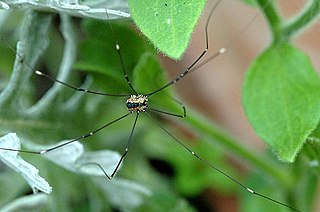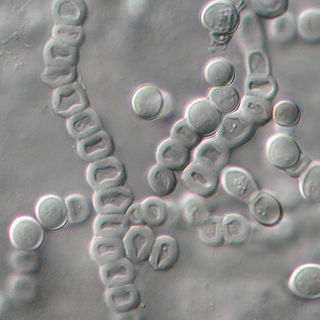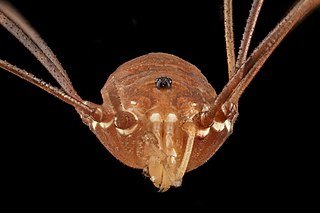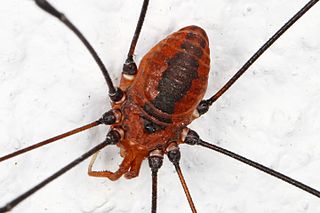In the geologic timescale, the Valanginian is an age or stage of the Early or Lower Cretaceous. It spans between 139.8 ± 3.0 Ma and 132.9 ± 2.0 Ma. The Valanginian stage succeeds the Berriasian stage of the Lower Cretaceous and precedes the Hauterivian stage of the Lower Cretaceous.

Leiobunum is a genus of the harvestman family Sclerosomatidae with more than a hundred described species. Contrary to popular belief, they are not spiders, although they share a resemblance. They are arachnids, in the order Opiliones, harvestmen. Species in Leiobunum tend to have relatively long legs compared with other harvestmen, and some species are gregarious.

Leiobunum rotundum is a species of harvestman. It is found in the western Old World.

Scleroderma verrucosum is a basidiomycete fungus and a member of the genus Scleroderma, or "earth balls". First described scientifically in 1791, the species has a cosmopolitan distribution, and grows in the ground in nutrient-rich, sandy soils.

Trichophyton verrucosum, commonly known as the cattle ringworm fungus, is a dermatophyte largely responsible for fungal skin disease in cattle, but is also a common cause of ringworm in donkeys, dogs, goat, sheep, and horses. It has a worldwide distribution, however human infection is more common in rural areas where contact with animals is more frequent, and can cause severe inflammation of the afflicted region. Trichophyton verrucosum was first described by Emile Bodin in 1902.
Penicillium verrucosum is a psychrophilic fungus which was discovered in Belgium and introduced by Dierckx in 1901. Six varieties of this species have been recognized based primarily on differences in colony colour: P. verrucosum var. album, P. verrucosum var. corymbiferum, P. verrucosum var. cyclopium, P. verrucosum var. ochraceum, P. verrucosum var. melanochlorum and P. verrucosum var. verrucosum. This fungus has important implications in food, specifically for grains and other cereal crops on which it grows. Its growth is carefully regulated in order to reduce food spoilage by this fungi and its toxic products. The genome of P. verrucosum has been sequenced and the gene clusters for the biosyntheses of its mycotoxins have been identified.
Leiobunum townsendi is a species of harvestman in the family Sclerosomatidae. It is found in North America.
Leiobunum bracchiolum is a species of harvestman in the family Sclerosomatidae. It is found in North America.
Leiobunum bimaculatum is a species of harvestman in the family Sclerosomatidae. It is found in North America.
Leiobunum crassipalpe is a species of harvestman in the family Sclerosomatidae. It is found in North America.

Leiobunum nigropalpi is a species of harvestman in the family Sclerosomatidae. It is found in North America.
Leiobunum relictum is a species of harvestman in the family Sclerosomatidae. It is found in North America.

Leiobunum flavum is a species of harvestman in the family Sclerosomatidae. It is found in North America.
Leiobunum politum is a species of harvestman in the family Sclerosomatidae. It is found in North America.

Leiobunum vittatum is a species of harvestman in the family Sclerosomatidae. It is found in North America.

Leiobunum aldrichi is a species of harvestman in the family Sclerosomatidae. It is found in North America.

Leiobunum calcar is a species of harvestman in the family Sclerosomatidae. It is found in North America.
Leiobunum euserratipalpe is a species of harvestman in the family Sclerosomatidae. It is found in North America.
Leiobunum uxorium is a species of harvestman in the family Sclerosomatidae. It is found in North America.
Phebalium verrucosum is a species of shrub that is endemic to New South Wales. It has branchlets densely covered with white scales, narrow elliptic, oblong or linear leaves covered with white scales on the lower side, and umbels of creamy white flowers with silvery or rust-coloured scales on the back of the petals.









